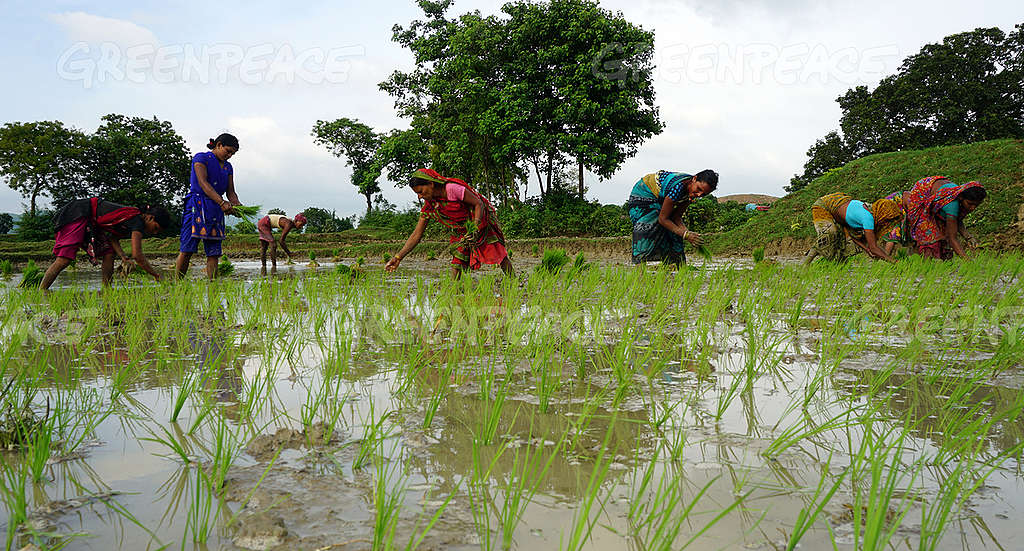
We can’t afford destruction of our Rice Heritage
Will you believe me if I say that till late 1960s we, the Indians, were proud owners of over 110 thousand indigenous varieties of rice? Believe it or not, it is true. And it is also true that in the last 40-50years we have lost more than 93.6% of our rice heritage. Proponents of industrial agriculture would argue that for building food security for the nation we had to take tough measures and that has given dividends as well. In 1966-67 India had to import 20 million tonnes of foodgrains to feed its hungry population and in 2020-21 we were able to export agri and allied products worth 29,814.45 million USD out of which 18,724.68 million USD was from foodgrains. This turnaround can only be accredited to the use of hybrid seeds and increased use of agro-chemicals. This argument looks very convincing, no? Interestingly, the fact is a little different, rather altogether different because, 94% of the seeds used for rice cultivation are open pollinated varieties and merely 6% comes from hybrid varieties which are developed by 70 private and 35 public sector companies. So, the truth is that our national food sovereignty and security of food are rooted in open pollinated seeds and not in the hybridized ones.
Knowingly or unknowingly, we systematically destroyed the rice diversity and the great genetic pool our foremother and forefather farmers developed over thousands of years.
The great legacy called Rice
It is believed that the first edible rice variety was developed as early as 13000-15000 years back. The earliest remains of the grain in the Indian subcontinent have been found in the Indo-Gangetic Plain and date from 7000–6000 BC.
There is a record that rice cultivation goes as long as 4 to 5 thousand years in the undivided Bengal and Kattiyanamn, a rice variety, has a history that dates back to 400 BC in Kerala. In Kerala alone there were over 3000 rice varieties and the undivided Bengal had the honour to have more than 15000 such varieties out of which more than 2000 deepwater rice varieties are believed to be grown in Bangladesh alone whereas Asia has over 6000 such varieties.
Much ado about diversity
One can argue why there is so much hullabaloo for rice diversity? First and foremost, a diverse and complex agroecology can survive the climate change challenges. Our diversity-rich rice repository has answers to most of the climate change and other agronomic crises. There are several rice varieties which are salinity tolerant, many are drought resistant while many are flood resilient. Dr Debal Deb, an ecologist and a celebrated rice conservator, alone has two species that can grow in 12 feet deep water, 16 varieties of rice that are drought tolerant and can survive without irrigation, 11 varieties that can grow in salinity affected areas and 200 varieties that can grow in 4-5 feet of water and 152 different aromatic varieties. “These are their natural properties that can never be imagined by genetic engineers,” he says. He grows more than 1420 rice varieties every year.
Rice wisdom among communities
When I was working with dam affected communities in different parts of the country, I witnessed farmers harvesting rice in a boat close to Ghosikhurd Dam near Nagpur and Hirakud Dam in Odisha. This kind of rice cultivation was also reflected by Kosi flood affected communities of North Bihar districts. Farmers of these water logged and flood impacted regions gave detailed accounts of rice varieties which were grown earlier in such areas and how they helped the local communities in keeping their food and nutritional security intact even in extreme conditions. They were quite clear in articulation that the depletion of rice diversity and dependence on the ‘sarkari’ seeds is among the major reasons for crop failures during the floods.
In her book, Khazan Ecosystems of Goa, marine microbiologist Sangeeta Sonak writes, “Khazans are predominantly rice and fish fields. They are reclaimed wetlands, salt marshes and mangrove areas where tidal influence is regulated by the construction of embankments and sluice gates.” Khazans, and the rice varieties grown there, are more than 3,500 years old. These rice varieties are resilient to saltwater. There is hardly any hybrid seed variety which can stand saltwater.
Similarly, many elderly farmers of Central Indian tribal communities from Maharashtra, Madhya Pradesh and Chhattisgarh had elaborate accounts of those rice varieties which hardly needed irrigation. They observed that the new rice seeds are highly vulnerable to weather fluctuations and need a lot of chemical inputs including synthetic fertilizers and pesticides. Tuntun Yadav and Indradev Yadav from Bihar Living Soils Model Village, Kedia are experimenting with different folk landrace varieties and are harvesting good crops for the last 3-4 years. They also have a lot to add to the benefits of growing landrace varieties. “These varieties do not require any extra soil fertilization and can grow as tall as 7ft high with minimal irrigation. We do not need to use any kind of synthetic pesticides while cultivating these crops’ ‘ informs Tuntun Yadav. “The per acre yield is a little less than the company seeds but these grains cannot be compared with the market ones in terms of aroma and taste so we get much better price for them” continues Tuntun Yadav. Indradev Yadav says that people search for our varieties especially for preparing ‘prasadas’ for special festivals like Chhath when purity is highly appreciated.
Rice as a cultural identity
This is in complete accordance with my interactions with tribal communities of Odisha who told me that they still look for the landrace varieties for preparing offerings for Nuakhai festival. Rice is closely linked to many festivals across India; Makar Sankranti, Onam, Pongal, Nabanna are a few to count. Dr Deb also talks of rice varieties which are specifically used for preparing special food during festivals in West Bengal. In an article he writes, “specific rice varieties shape the food cultures of different areas and districts. Moa, the famous rice sweet of Jaynagar in the district of South 24 Parganas, bears the unique aroma of Kanakchur, an indigenous landrace. The farmers of Bankura, Puruliya, Jalpaiguri and South 24 Parganas grow Kelas, Dahar Nagra, Nalpai and Moul for their famed crisped rice (moori). Sita-sal and Banshkathi are favoured around Paschim Medinipur district for their quick cooking time, rich taste and slender grains. Ajirman, Chandrakanta and Manik Kalma are chosen for beaten rice (chireh).”
Nutritional qualities of native rice varieties
Dr Deb talks of rice varieties high in nutraceutical values, “Some of these rice varieties like Kalabhat (39 mg/kg), Parmai Sal (42.5 mg/kg), Navara, Norungan, etc contains high amount of iron and were given to women to cure anaemia during pregnancy.” In his repository there are at least 67 varieties of rice that have a sizable presence of iron. Badshah Sal is a variety that has 138 mg/kg of iron and is much better than Monsanto’s MS-13 that has an iron content of 7 mg/kg. “Similarly, there are rice varieties with antioxidant properties that can prevent cancer, omega-3 and minerals like zinc and magnesium.” The evergreen malnutrition and anaemia is the hallmark of our food security claims. The white or polished rice is the most commonly available grain in the markets as well as the Public Distribution System outlets. White or polished rice might have the equal amounts of calories, carbohydrates, proteins and oils but are completely devoid of several micronutrients like beta carotene (a precursor of vitamin A); B vitamins like thiamin, riboflavin and niacin; and metals like iron and zinc as all of these are present in the barn or coats which is destroyed or artificially extracted while polishing the grain. Dr Lijy Thomas, a known gynecologist and obstetrician in her paper compares the nutraceutical benefits of polished and unpolished rice grains and says that the polished rice has little to contribute to human health. Ironically, the green revolution and monoculture-based industrial agriculture and food system tends to rely completely on polished rice.
Unfortunately, these rice varieties are not promoted to strengthen the community based food and nutritional sovereignty and unproven technology solutions such as genetically modified and/or mandatory fortification are forwarded as the silver bullet to address the challenges of malnutrition and anemia. Such efforts are in complete contradiction with the local wisdom and climate resilient diversity-based food production system.
How can we protect rice diversity?
As aware and responsible consumers we can create a demand for unpolished and diverse rice varieties which would encourage our farmers to grow them. This way we can jointly work to create a sustainable and resilient food system which ensures food sovereignty and nutritional security to all while strengthening the agrobiodiversity.

Ishteyaque Ahmad
Senior Food For Future Campaigner
